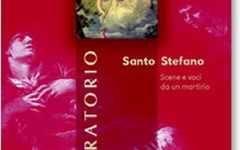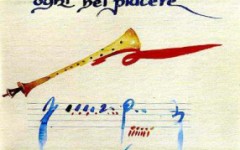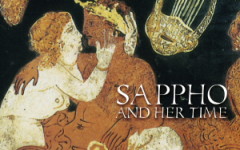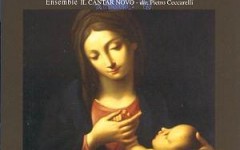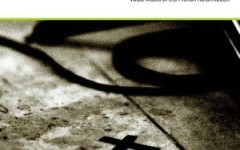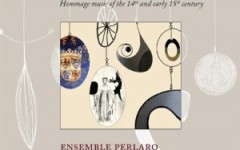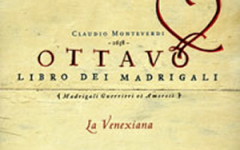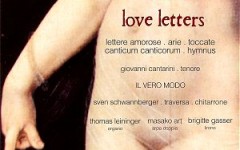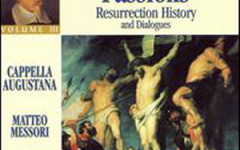Sotto l’imperio del possente prince – Ens. Perlaro
Godi, Firençe (Paolo Da Firenze)
Lorenza Donadini, Agnieszka Budzinska, soprani
Giovanni Cantarini, tenore
Sotto l’imperio del possente prince
Nel suo poderoso volume su Francesco Petrarca, il grande poeta e il «primo» umanista nella storia della cultura italiana, Karlheinz Stierle scrive: «Il Trecento è il primo secolo in cui si presagisce l’età moderna.» Ciò vale particolarmente per l’Italia, in cui l’insorgere dell’Umanesimo avvenne prima rispetto agli altri paesi europei. Fu un secolo difficile e importante, da ogni punto di vista: la popolazione fu afflitta da catastrofi naturali, da guerre e dalla peste – carestie, povertà e imbarbarimento ne furono le conseguenze. Eppure il Trecento italiano fu ricchissimo di opere d’arte, di capolavori letterari e innovazioni musicali. La musica italiana del Trecento, cui è dedicato il presente CD, nella sua copiosità e originalità rispecchia l’orizzonte intellettuale dell’élite contemporanea, che malgrado le avversità esterne pose la propria vita al servizio della filosofia, della musica e della lingua, gettando le basi per una nuova concezione del mondo che noi oggi chiamiamo Umanesimo. I testi delle opere di questa registrazione trattano di politica e d’amore. La lirica amorosa segue il concetto dell’amore cortese, che nella tradizione italiana è sempre legato alla venerazione della Vergine Maria. La dama adorata è spesso paragonata ad una stella, ad esempio, che richiama la denominazione stella maris per la Madonna, così come l’immagine che la dama risplenda più del sole è ricorrente nei testi dedicati alla Madonna. Si pensi per esempio all’ultimo componimento del Canzoniere di Petrarca: Vergine bella che di sol vestita. Frequente è anche il paragone con i fiori, in particolare con le rose come nelle ballate O bella rosa o Amor mi fa cantar a la Francesca. La poesia trecentesca impiega anche confronti con il fiore del melograno o il bianco fiore del ligustro. Un ruolo importante nella storia d’amore cortese è giocato dagli occhi: l’amante viene colpito dallo sguardo della dama come da una freccia, e se la sua adorata non si impietosisce, gli si prospetta una misera morte. Quindi è necessario un secondo sguardo da parte della dama che rassicuri l’amante e lo faccia perseverare nella sua servitù amorosa. Il titolo di questa registrazione Sotto l’imperio del possente prince è il primo verso del madrigale di Jacopo da Bologna. I musicisti del tempo dipendevano dal favore di un principe e, per guadagnarsi la sua attenzione, componevano numerosi canti encomiastici, soprattutto in occasione di vittorie (Godi Firenze), matrimoni o altre solennità. Tra i più eminenti principi dell’Italia settentrionale figura Giangaleazzo Visconti, vissuto tra il 1351 e il 1402, che dal 1397 diviene Duca della Lombardia. Giangaleazzo non solo si dedicò all’espansione del suo dominio, ma promosse anche le arti alla sua corte. Musici e compositori quali Jacopo da Bologna o Johannes Ciconia furono al suo servizio, due spiriti critici degli albori dell’età moderna. La loro osservazione dell’ambiente sociale è acuta e attenta; molti brani che a prima vista sembrano puramente encomiastici, contengono in verità anche un’aspra critica al regnante. Spesso i rapporti di dipendenza lasciano un «gusto amaro» (Lo lume vostro, Jacopo da Bologna). Proprio Jacopo, spirito colto e arguto, seppe unire magistralmente nelle sue opere vari livelli di significato, dando vita ad un’armoniosa unità esteriore, le cui contraddizioni emergono solo da un’analisi più approfondita. Nel mottetto Lux purpurata, Jacopo esorta i reggenti alla giustizia e a non essere ostili verso gli altri, al fine di garantire pace e sicurezza ai sudditi. Il mottetto Francorum nobilitati di Beltrame Feraguts fu scritto probabilmente per Niccolò d’Este, duca di Ferrara. Il riferimento iniziale all’aristocrazia francese è forse dovuto al fatto che, nel 1431, Niccolò ottenne dal re francese Carlo VII il diritto di aggiungere allo stemma della sua famiglia le insegne della casa reale di Francia, tre gigli d’oro su campo azzurro. L’ultimo brano del disco non riguarda un principe, ma il cardinale Francesco Zabarella (1360–1417), docente di giurisprudenza all’università di Padova, che ebbe un ruolo decisivo nel concilio di Costanza (1414–1418). Il testo del mottetto Ut te per omnes celitus/Ingens alumnus Padue di Johannes Ciconia invoca la protezione di san Francesco per l’omonimo ed eminente professore di legge. «Ascolta con favore, degnando le preghiere del dottore immenso, o sacro Francesco; per mezzo suo la stirpe di Antenore prende le buone leggi». Antenore, un personaggio dell’Iliade di Omero, era uno dei più vecchi saggi di Troia. Nel Trecento italiano il dibattito sulla questione della lingua era molto acceso. Si doveva scrivere in italiano o in latino? La Divina Commedia scritta in volgare da Dante costituisce una pietra miliare, anche se non fu lui il primo a impiegare il volgare per i testi letterari. Il latino continuò a essere la lingua impiegata per i testi politici ed eruditi. La discussione linguistica sul ruolo e sul rango dei due idiomi, tema centrale degli albori dell’età nuova, è percepibile anche sui testi dei componimenti musicali qui presenti. Tutte le canzoni su tema amoroso sono scritte in italiano e in forma di ballata, i testi dei mot tetti con soggetto politico sono invece in latino, mentre i madrigali con soggetto politico di Paolo da Firenze e Jacopo da Bologna hanno testi in volgare. Il latino dei mottetti è dovuto alle convenzioni del genere piuttosto che al contenuto politico. Il madrigale medievale invece (che non va confuso con quello del Cinquecento!) è una forma poetica con uno schema metrico fisso, impiegata generalmente per la poesia amorosa, ma anche per scene della vita quotidiana e inoltre per canti encomiastici. Il ritornello finale offre l’occasione di chiudere con una dichiarazione arguta, impiegata volentieri nei testi di carattere politico. Il ritornello si distingue dagli altri versi sia nel testo sia nella musica, introducendo per esempio un nuovo concetto o un altro ritmo. Poiché esso risuona alla fine della canzone, il poeta può impiegare questa sezione per le conclusioni. Non bisognava necessariamente scegliere tra il latino e l’italiano, i poeti trecenteschi potevano anche combinare due o più lingue. Il testo del madrigale Lo lume vostro dolce’l mio signore di Jacopo da Bologna, il madrigale encomiastico insaporito da un pizzico di amarezza, è in italiano e in latino. Questo bilinguismo è frequente e non è prerogativa della poesia italiana, anche se gli esempi non sono numerosi. Non è un innocuo capriccio o un gioco da poeti, anzi, proprio nel poliglottismo si celano satire e ambigui sarcasmi. Si potrebbe dire che l’ambiguità linguistica rimandi alle sfaccettature semantiche del contenuto. Chi erano gli autori dei testi musicati? Nella maggior parte dei casi i poeti sono ignoti, ma spesso si può supporre che il compositore stesso sia anche l’autore dei versi. Al contrario del nome dei poeti delle opere musicali, per il Trecento il nome dei compositori è generalmente conosciuto, ma purtroppo in molti casi mancano le informazioni biografiche. Studiando svariate fonti in difficoltose ricerche, i musicologi tentano di collocare questi compositori nel loro contesto storico e culturale. Centinaia di composizioni musicali sono tramandate in un buon numero di manoscritti, ma cosa sappiamo infine di Giovanni o di Andrea da Firenze? Non abbiamo alcun dato anagrafico. Francesco Landini, il grande maestro della musica trecentesca, è colui di cui sappiamo di più: L’organista cieco era già noto in vita oltre i confini della sua città, Firenze. Solamente le opere nel codice Rossi, che essendo stato redatto intorno al 1370 costituisce la collezione più antica pervenutaci, sono anonime, salvo pochi pezzi attribuibili grazie a un confronto con altri codi ci. Nonostante la mancanza di dettagli biografici, è evidente che questo repertorio musicale sia formato da grandi personalità musicali che seppero sviluppare uno stile individuale. Con questo repertorio che si estende dal codice Rossi fino a Beltrame Feragut, il presente disco offre un florilegio della musica del Trecento e del primo Quattrocento, nata nei centri culturali di Milano, Firenze o Ferrara non solo dedicata ai Principi, ma anche all’amore cortese. Nicoletta Gossen (Traduzione: Martina Papiro)
ensemble Perlaro
Dopo cinque anni di attività, l’ensemble Perlaro si è rivelato come uno dei più interessanti fra i gruppi emergenti di musica medievale. Consacrata per volontà della sua fondatrice Lorenza Donadini, al repertorio trecentesco italiano, la compagine internazionale degli artisti si è formata in seno alla Schola Cantorum Basiliensis da cui ha tratto tutta la tradizionale solidità accademica di preparazione e al contempo una fresca e vigorosa vena interpretativa dovuta proprio alla diversità dei suoi elementi e alle loro specifiche competenze. Un albero carico di frutti, un olmo presso un fiume regale, è il significato del nome Perlaro, immagine che si staglia, quasi un’antica impre sa, nel paesaggio prezioso e immaginario dei madrigali dedicati agli Scaligeri, signori di Verona. Vere e proprie perle sono infatti i frutti che il lavoro filologico del gruppo fa brillare ai nostri orecchi: dai virtuosistici madrigali del codice Squarcialupi, alle briose ballate monodiche del codice Rossi, dai mottetti dello stupefacente Ciconia alle laudi vibranti di calda religiosità e per andare oltre ai limiti cronologici del Trecento e affacciarsi sul secolo successivo, le sospirose ballate del codice Canonici, dove in mezzo ai nomi quasi sconosciuti di autori non certo meno geniali, campeggia il ben noto Dufay. Tutto questo è stato accolto con successo dalla critica e dal pubblico, in festival come MITO (Milano), Notti Malatestiane (Rimini), Cantar di Pietre e Ceresio estate (Ticino) e in tournée impegnative come quella in Cina (Century Theatre – Pechino, Ambasciata Svizzera – Pechino, City Theatre di Heyuan (Guangdong)).
Giovanni Cantarini
About the program and the group
Sotto l’imperio del possente prince
In his comprehensive work about Francesco Petrarca (Petrarch), the great poet and «first» humanist of Italian cultural history, Karlheinz Stierle wrote: «The 14th century is the first century which anticipates modern times.» This is especially true of Italy, where the dawn of humanism was experienced some time earlier than elsewhere in Europe. It was an important and difficult century in every respect: people were afflicted by natural catastrophes, martial conflicts and the plague, of which famine, poverty and barbarisation were the dismal consequences. Yet in spite of all this, the 14th century generated an incalculable abundance of artistic masterpieces, literary works and musical innovations. The music of the Italian Trecento presented on this recording reflects the intellectual world of the élite at that time, both in terms of its diversity and originality. Despite all external hindrances, this intellectual world devoted itself to the service of philosophy, music and language, thereby establishing the foundations for that new perception of the world which is now referred to as humanism. The texts of the works heard on this CD correspond to the two themes of politics and love. The love poetry is embedded within the concept of courtly love, which, in the Italian tradition, also had a strong association with the adoration of the Virgin Mary. Thus, for example, the revered lady was frequently compared to a star, calling to mind the designation of stella maris for the Virgin. She was also said to shine more strongly than the sun, which is likewise an image from the adoration of the Virgin. Here, one thinks of the concluding poem of Petrarca’s Canzoniere Vergine bella che di sol vestita. Comparisons to flowers were widespread, particularly to the rose, as is apparent in the ballate O bella rosa and Amor mi fa cantar a la Francesca. Comparisons to other flowers also appear in the lyrics of the Trecento such as to those of the pomegranate and privet. Another important role in the courtly love story is taken by the eyes. The lover is struck by the lady’s glance as if by an arrow, and if the beloved does not take pity, a wretched death awaits him. A second look from the lady is thus necessary, which in turn gives him so much hope that he remains steadfast in his service of love. The title of this recording, Sotto l’imperio del possente prince (Under the dominion of the powerful prince), is taken from the opening line of a madrigal by Jacopo da Bologna. At that time, musicians were dependent on the favours of sovereigns, and in order to impress, they composed numerous «occasional works», especially in celebration of significant victories (Godi Firenze), marriages or other festivities. One of the most important North Italian princes was Gian Galeazzo Visconti (1351–1402), who was not only keen to expand his territories (even managing to gain control of Milan in 1385), but was also anxious to encourage the arts at his court. Many distinguished masters spent time in his service, including Jacopo da Bologna and Johannes Ciconia, two crucial figures of the «century which anticipates modern times». They paid close attention to their surroundings, and many of their works which at first appear to be merely occasional in fact conceal a good deal of sharp criticism of their rulers. The «gusto amaro» is added to quite a few of these pieces (as in Jacopo da Bologna’s Lo lume vostro). Jacopo, an erudite and astute mind, particularly understood how to combine various levels of meaning to great effect, producing an externally rounded entirety whose inconsistencies are only unveiled on close analysis. In his motet Lux purpurata, the princes are admonished to exercise justice and to avoid being hostile to anyone in order to ensure peace and safety for their subjects. Beltrame Feragut’s motet Francorum nobilitati was possibly written for Niccolò d’Este, Marquis of Ferrara. The connection to the French nobility, alluded to at the beginning of the text, probably refers to Charles VII’s grant of permission to Niccolò in 1431, allowing him to complement the eagle in his coat of arms with three golden lilies on a blue base, the symbol of the French royal house. The last piece on this recording does not concern a prince, but rather a cardinal, Francesco Zabarella (1360–1417), who played an important role at the Council of Constance (1414–18) and taught law at Padua University. The text of the motet Ut te per omnes celitus/Ingens alumnus Padue by Johannes Ciconia invokes the protection of St Francis for the great jurists who carried his name: «Listen with favour to the worthy prayers of the great scholar, O holy Francis; through him, the line of Antenor is given good laws.» (Antenor, a figure from Homer’s Ilias, was one of the wisest ancients in Troy.) In the 14th century, there was much debate concerning language. Should one write in Italian or Latin? Dante’s Divina Commedia, written in the vernacular («volgare»), marks a turning point in this respect, although admittedly he was not the first to write in the Italian language. However, scholarly and political texts were still mostly written in Latin. The linguistic discussion about the significance of both languages was a central theme in Italy in this epoch «which anticipates modern times», and it is reflected in the texts of the musical works presented here. All the pieces about love are in Italian and written in the form of the ballata, whilst the occasional motets are in Latin, and the political madrigals of Paolo da Firenze and Jacopo da Bologna are in Italian. Thus the use of Latin in the motets probably stems from the roots of the genre rather than their political content. The madrigal of the Middle Ages (not to be confused with the 16thcentury madrigal!) was a typical form of Italian poetry and was used in most instances for love lyrics or scenes from everyday life. However, the form of the madrigal was also chosen for «occasional works». One reason for this may be that the concluding ritornellos offered the possibility of a climax (thematically speaking) which was particularly appealing in politically-motivated texts. Textually and musically, the ritornello breaks away from the rest of the piece, for example by introducing new ideas or utilising another rhythm. Since it is heard at the end of the song, the poet can use this part to function as a final conclusion. Alongside the choice between Latin and Italian texts, a third possibility was open to the Trecento poets: namely, the combination of two or more languages in the same text. Jacopo da Bologna’s madrigal Lo lume vostro dolce’l mio signore, induced with a hint of bitterness, is texted in Italian and Latin. Bilingualism was not only used repeatedly in the Italian lyric of that time, even though the extant examples are few in number. Far from being used as a mere whim or innocent trick by the (respective) poet, hidden satire and sarcastic ambiguity is found frequently, particularly in the texts written in two or more languages. One could interpret this linguistic double meaning as symbolising the multi-layering of the content. Who were the poets? In the vast majority of cases, we do not know who wrote these texts, although it can be assumed that the composer was often the writer of the verse set to music. In contrast to the poets, the names of a number of composers in the Trecento are well known. Unfortunately, however, detailed biographical information is lacking in many cases. By undertaking painstakingly detailed study and drawing upon every possible type of source, musicology has managed to place these composers in some sort of historical and cultural context. Hundreds of pieces of music are preserved in an impressive number of manuscripts; yet what do we actually know, for example, about Giovanni or Andrea da Firenze, to say nothing about precise biographical data? Fortunately, the facts concerning Francesco Landini, the blind organist and great master of Italian Trecento music, have been better preserved. Landini was already known in his home of Florence and far beyond even in his own lifetime. Only the works in the Rossi Codex (c. 1370), the earliest extant collection of Trecento music, are anonymous, save a few exceptions which can be given ascriptions thanks to concordances in other manuscripts. That said, the lack of biographical data should not disguise the fact that one encounters very distinctive personalities in this repertoire who developed their own, idiosyncratic style. With a repertoire that ranges from the Rossi Codex to Beltrame Feragut, the present recording offers a rich sampling of music from the 14th and early 15th centuries, which, in the cultural centres of Milan, Florence and Ferrara, was not only in praise of the princes, but was also written in the spirit of courtly love. Nicoletta Gossen (Translation: Richard Robinson)
ensemble Perlaro
After five years of working together, ensemble Perlaro has established itself as one of the most exciting groups emerging in the field of medieval music. Founded in 2004 by Lorenza Donadini and focussing on Italian Trecento repertory, this international ensemble consists of musicians who met at the Schola Cantorum Basiliensis in Switzerland. There, the ensemble received its academic train ing which it now connects to a fresh and vigorous means of interpretation. The name Perlaro refers to a fruit-bearing tree, an elm near a royal river, an image (a quasiancient impresa) which is frequently found in the precious and imaginary landscape of the madrigals dedicated to the Scaligeri, the lords of Verona. The fruits of the in-depth philological work which the group brings to discerning ears can be seen, in fact, as true and real, from the virtuoso madrigals of the Squarcialupi Codex and the lively monodic ballate of the Rossi Codex to motets by Ciconia and laudi that resonate with warm religiosity. Going beyond the chronological boundaries of the fourteenth century and into the following century, their repertoire also encompasses the plaintive ballades of the Canonici Codex, which includes many significant names, like Dufay, amongst less well-known composers. Their work has been received enthusiastically by critics and public alike, as is reflected in their success at the MITO Festival (Milan), Notti Festival Malatestiane (Rimini) and the Festival Cantar di Pietre and Ceresio estate (Tessin, Switzerland), as well as in concerts in China (Century Theatre – Peking, Swiss Embassy in Peking, Heyuan City Theatre (Gangdong).
Giovanni Cantarini (Translation: R. Robinson)
